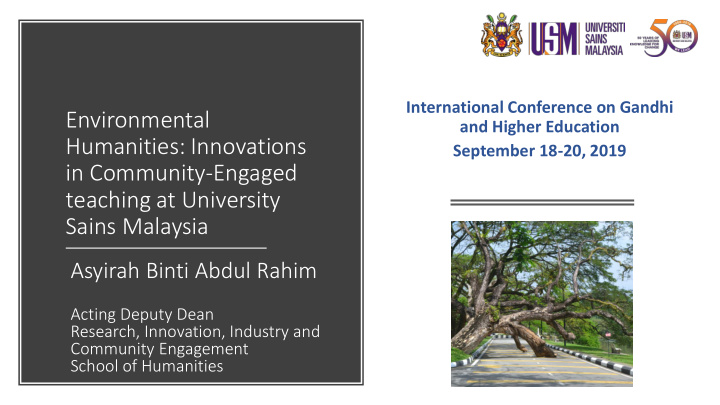



International Conference on Gandhi Environmental and Higher Education Humanities: Innovations September 18-20, 2019 in Community-Engaged teaching at University Sains Malaysia Asyirah Binti Abdul Rahim Acting Deputy Dean Research, Innovation, Industry and Community Engagement School of Humanities
UNI NIVERSIT SITI I SAI AINS MALA MALAYSIA IA • Established as the second university in the country in 1969, the present campus is on 416.6 hectare site at Minden, Penang • 17 Academic Schools on the main campus in the island of Penang; • 6 Schools at the Engineering Campus in Nibong Tebal • 3 at the Health Campus in Kubang Kerian, Kelantan (approximately 300km from the main campus). • 17 dedicated research centres (wide range of specialisations).
9 AP APEX TH THRUS RUSTS 1. Knowledge 2. The future 3. Uniqueness 4. Sustainability 5. Humanity 6. Universality 7. Change 8. Sacrifice 9. Wellness*
*Thrust - Wellness • All relevant endeavours are aimed to actualise harmonious mental and physical characters to all including the university community and extending to the citizens of the nation and the world resulting from continual, sustainable thoughts and actions encompassing physical, spiritual and moral development as well as continual blissfulness.
originally the School of Cultural and Community Studies. It was established in 1970, a year after the School of inception of Universiti Pulau Pinang Humanities (predecessor of the present Universiti Sains Malaysia). liberal arts- oriented and were set up to provide a balance in terms of the focus of the University so that emphasis would not be placed solely on the sciences and technology.
• Geography • History • Malay Language Linguistic Studies • English Language Studies • Islamic Studies • Literature • Philosophy and Civilisation • Translation & Interpreting Studies School of Humanities
Environmental Humanities “.. a diverse and emergent field of cross -disciplinary research that seeks to analyze and investigate the complex interrelationships between human activity (cultural, economic, and political) and the environment, understood in its broadest sense.” The Oxford Research Centre for the Humanities (TORCH) 7
HGG250/3 Society, Space and Environment • Class Assignment: USM as Sustainable Campus – Location, Space and Functions Teaching HGT342/4 Research Methods and Geography Fieldwork • Fieldwork Project 1: Cultural Ecosystem Services of Urban-Blue Spaces • Fieldwork Project 2: Ecotourism and Wetland Conservation
An elective course for major Geography in BA Geography programme HGG250 SOCIETY, SPACE A compulsory course for minor AND Sustainability Studies ENVIRONMENT 1 semester course
Students engagement with campus community • Identify location and spaces • Learning Spaces • Leisure Spaces • Food/ Café • Discuss and analyse spaces for sustainable lifestyle (e.g. waste, energy, design, safety) • Output: • Map of important spaces in USM Campus • Positive and negative experiences of using the campus spaces USM as Sustainable Campus • Recommendations to improve the spaces
An compulsory course for major Geography in BA Geography programme HGT342 GEOGRAPHY RESEARCH 2 semesters (4 units) METHODOLOGY AND FIELDWORK Students working in groups, 7 weeks to 1 week in the field and 1 week at the university
Proje ject 1: : Ecotourism and Wetland Con Conserv rvation • Kuala Sepetang was formerly known as Port Weld, the first railway system in Malaya began on June 1, 1885 when 8¼ mile railway track connecting it and Taiping • Matang Mangrove Forest Reserve, the largest mangroves covering an area of about 41,000 ha. • Crescent-shaped measuring about 13 km wide in the middle and about 52 km between extreme ends of the northern coast of the state of Perak in Peninsular Malaysia. Comprises of 19 independently gazetted forest reserves. Mangrove trees are logged to produce charcoal • In recent years, the small town has become popular tourists destination especially for its seafood (especially prawns) and Eco-Tours.
W e lead “The world has enough for everyone’s need, but not everyone’s greed” - Mahatma Gandhi-
• Most of the eco-tour guides are fishermen with local knowledge of the river, mangrove and its biodiversity • Eco-tour guides were trained about management of the forest reserve and charcoal production (main product of mangrove trees). • They needed a map showing the attractions of the area and local stories for the tourists.
Project 2: Cultural Ecosystem Services of Urban Green-Blue Spaces • Urban green-blue spaces (e.g. urban A) Recreation & health parks, lakes & river corridors) – B) Aesthetic Values important for sustainable cities & communities C) Spiritual • Green-blue spaces provide bundled D) Social interaction ecosystem services E) Education & nature exploration • Visitor Employed Photographs (VEP) to map perceptions F) Sense of Identity • Enable the localization of the most G)Sense of Belonging highly valued ecosystems in a landscape • Allow the identification of critical focal areas for UES planning and management
Taiping A historical city and known for its natural heritage – tin mining and biodiversity Taiping Lake Garden covered with 2,300 trees and the beautiful scenery of the drooping branches of the 100 years old trees
Distribution of Cultural Ecosystem Values
• Cultural values provides information for space management – enhance benefits of urban spaces • Cultural values of Ecosystem services is important element to be considered by park and landscape planning and design • Knowledge on relationship between space and sense of belonging for community’s stewardship of urban green-blue spaces
Thank you
Recommend
More recommend